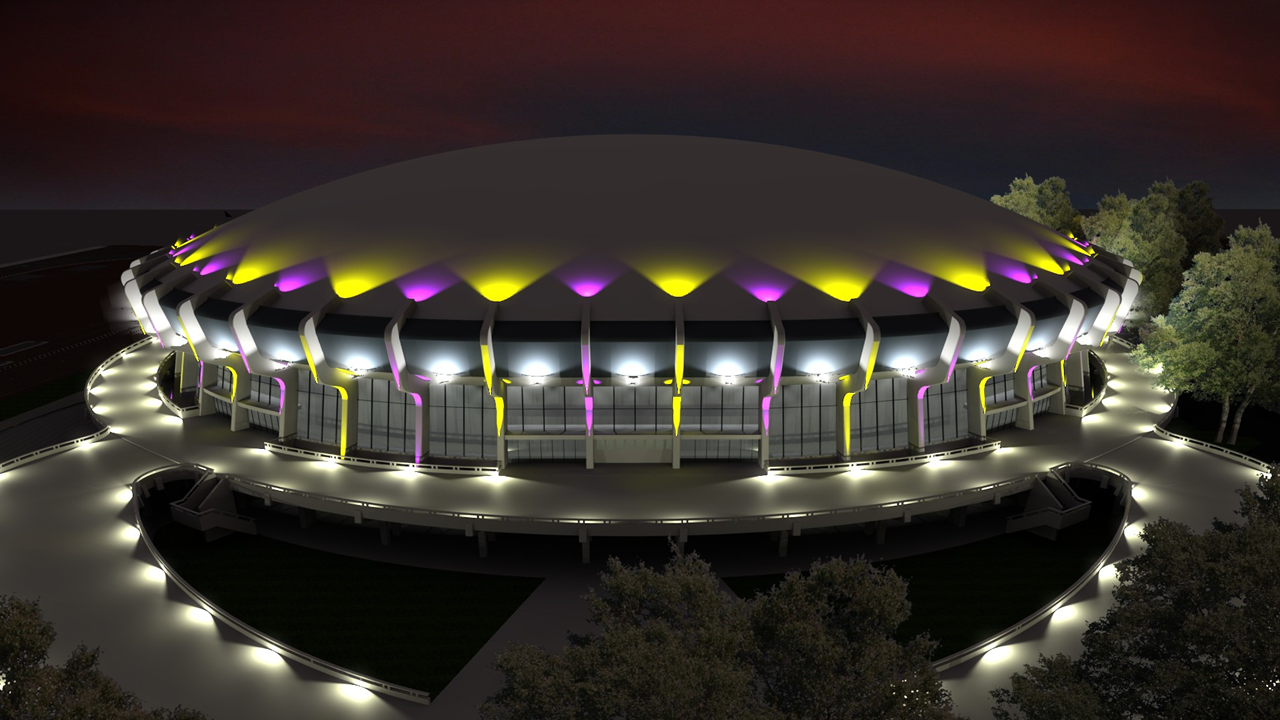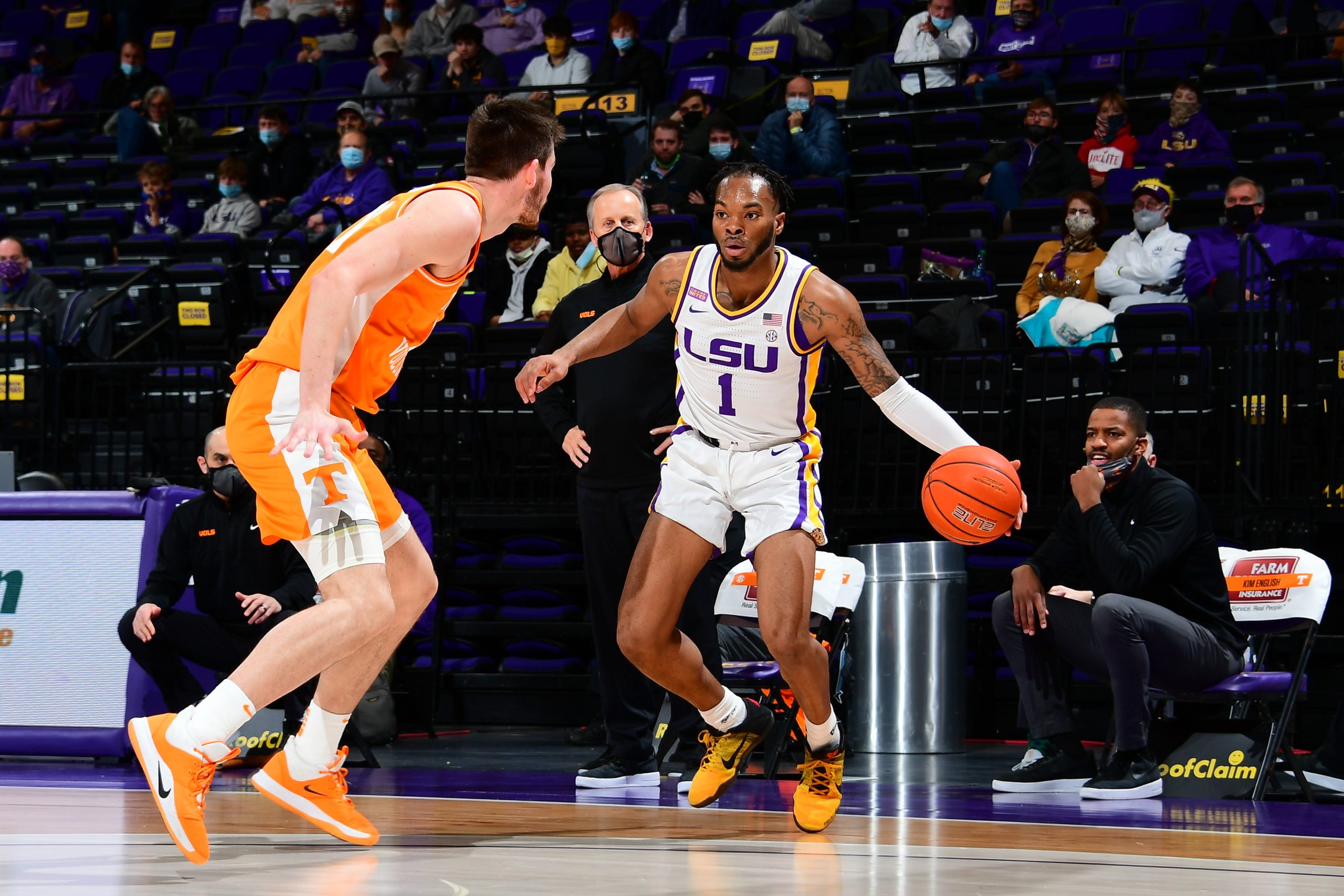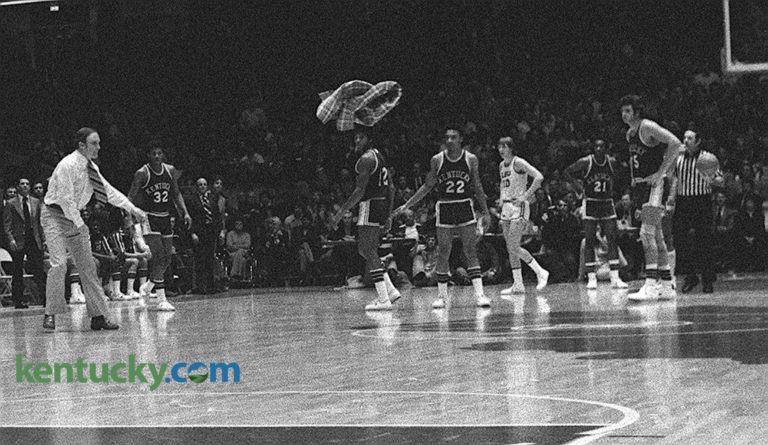
When 20-year-old Collis Temple Jr. walked into the brand-spanking new LSU Assembly Center in January 1972, he had just one thought in mind.
He had played the first two years of his college basketball career in John M. Parker Agricultural Coliseum. Back then, the building nicknamed “The Cow Palace” was almost a 35-year old venue built for rodeos and horse shows and attached to the livestock barn where the stench of dung wafted into the arena with the basketball court laid over the arena’s dirt floor.
“Our dressing room was little bitty,” Temple said. “It was all green tile, it had no heat, no showers, wooden benches and it didn’t have a damned backboard for the coach to draw plays on. It was like a little dungeon hidden away behind some floor bleachers.
“Then, you ran down wooden planks over the dirt to get to the court, but the whole place smelled like manure.
“So, when the Assembly Center opened, it was like moving from the outhouse to the White House.”
Re-named the Pete Maravich Assembly Center in 1988 shortly after the death of the LSU all-American guard whose legendary success fast-tracked construction funding of the $11.5 million arena, the PMAC starts its 50th basketball season this year.
When it was built, it was the third time in a 20-year period that one of the then-10 SEC members opened a new basketball arena. Now, PMAC is the fourth oldest arena in the 14-team league.
At its birth, the 14,351-seat Assembly Center (it has since been reduced to 13,251 after renovations) was like a futuristic spaceship had dropped in a vacant field between the Bernie Moore track stadium and the Gym Armory.
“I remember when I brought Jack Schalow, one my first assistants, in for a job interview,” said Dale Brown, who spent his entire 25-year LSU head basketball coaching career in the building starting in its second year of existence in 1972-73. “We walked out on the track and looked back at the arena.
“He said, `Damn almighty, that is beautiful.’ I said, `To be honest with you, it’s like the Taj Mahal.’ I’d never seen anything like it. I won my first and last games in it, so I have good memories in the beginning and in the end.”
Now, the PMAC is an aging lady, getting facelifts every now and then. It carries a notable history of unforgettable athletic events, memorable concerts and unforeseen uses like being a triage center in the aftermath of Hurricane Katrina in late August/early September 2005.
“It was a beautiful place and it’s still a very, very nice facility,” said now 68-year old Temple, whose LSU lifespan is bookended by being the first African American athlete in LSU history and in July being named to the school’s Board of Supervisors.
Hit the ground running
LSU officials started interviewing to find a director of the Assembly Center in 1970 two years before it opened. They didn’t find anybody they liked, so they hired a man in his mid 30s they never interviewed because they already knew of his capabilities.
Bill Bankhead, who served in the Marines in Korea and then was head cheerleader at LSU from 1956-58 as well as a member of the track team, was the Swiss Army knife of the LSU athletic department. He was the director of intramural sports and director of Olympic sports (“They called them `minor’ sports back then’,” Bankhead said), such as wrestling, swimming, gymnastics, golf and tennis.
“My biggest charge was I was told the building wasn’t going to be used exclusively for athletics, that we had to have other events like entertainment,” recalled Bankhead, 85, who still lives in Baton Rouge and attends LSU women’s gymnastics meets in the PMAC.
Bankhead got a crash course in scheduling events, getting entertainment booked and mixing it with LSU men’s and women’s home basketball games, men’s and women’s gymnastics meets, and men’s wrestling and women’s volleyball matches.
It wasn’t easy. When he wanted information on a prospective act to possibly book, there were no computers at that time he could tap into in a blink.
“I’d go look in Rolling Stone magazine or one of the periodicals on bookings,” Bankhead said. “We were fortunate our arena was just about the only one between Houston and Atlanta. The best promoter for me was Don Fox of Beaver Productions out of New Orleans.”
Promoters found themselves negotiating with Bankhead or 23-year old Jeff Elliott, an LSU business major working on a Masters’ degree. Bankhead hired him as a graduate assistant in the fall of 1971 as part of a four-person administrative staff.
It was the start of a 17-year run for Elliott, who became the building’s assistant director and then replaced Bankhead as director when Bankhead left to conduct the 1983 Special Olympics World Games and the 1985 U.S. National Sports Festival in Baton Rouge.
Elliott, who left the PMAC in 1988 to become a University of North Carolina assistant athletic director and director of UNC’s arena The Dean Smith Center, had contract negotiating dumped in his lap because there had been no plans to hire a financial expert.
“I learned on the job all the intricacies of contracts, it was kind of fly by the seat of your pants initially,” Elliott said. “I just got thrown to the wolves. I was savvy enough to pick it up pretty quickly.”
Bankhead said the first event in the Assembly Center was fall semester graduation in December 1971. The first entertainment act, magician Andre Kole, followed soon after. The first home varsity basketball game was LSU’s 80-73 men’s loss to Vanderbilt on Jan. 3, 1972, followed by the arena’s first concert on Jan. 30 featuring Johnny Cash. The first rock concert just more than a month later was Three Dog Night, an act Bankhead booked after taking a trip to watch the group perform live in San Antonio.,
The Cash and Three Dog Night shows began a flood of concerts, at least seven per year for 18 consecutive years, that featured the biggest rock and country acts and comedians on the planet.
In fact, 28 solo acts or bands on the Recording Industry Association of America’s (RIAA) list of the 50 best-selling music artists of all-time (updated in September) played in the Assembly Center including the seven of the top 10 acts and a solo appearance by a member (George Harrison) of the Beatles, the best-selling artists ever.
Many of those acts appeared multiple times – Elvis Presley, Elton John, Bruce Springsteen and The Eagles – just to name a few.
“The one thing we did pride ourselves on was trying to make sure we ended up with a win-win relationship with all the promoters,” Elliott said. “If they were (financially) losing their ass, I tried to help them. You treat people like that, they come back. That’s one thing I learned that carried me the rest of my career.
“From the mid 70s to the mid 80s, we were one of the busiest buildings in the South. We were hot for a long, long time.”
From 1975 to 1977, the Assembly Center hosted 51 concerts. It wasn’t unusual in the span of a two-week period to watch Bob Dylan and Bruce Springsteen fill the building (May 4 and 8, 1976 respectively) or Led Zepplin and Elvis Presley (May 19 and 31, 1977 respectively).
Twice on April 28-29-30 in 1977 and 1978, the building staged three different concerts (Pink Floyd, Neil Diamond and Willie Nelson/Waylon Jennings, then the next year Foghat, Willie Nelson and John Denver) in three days.
“We had three different seating configurations for the three shows,” Elliott said. “You had to break down the configuration for each of them and go on to the next one.”
Mick Jagger, the concert that never happened and naked people
The most ballyhooed Assembly Center event was June 1, 1975 when The Rolling Stones kicked off their world tour.
“The Stones were here for about four days rehearsing,” Elliott said.
Bankhead said the Stones provided a couple of unexpected surprises.
“They built a rake stage where it was lower in the front and higher in the back,” Bankhead said. “We didn’t know under the rake stage there was a pop-out stage of about four or five feet.
“The promoters talked us into having 2,000 people on the floor standing in front of the stage. Then, they popped out that floor and pushed 2,000 people back four feet because the pop-out stage was used for all the band’s inflatable props, like Mick Jagger riding that huge inflatable penis.”
Also, the Stones were supposed to stage two separate shows with different start times, but. . .
“It turned into one because they didn’t stop playing,” Bankhead said. “We ended up with 32,000 people trying to get in the building that night.
“The Rolling Stones hadn’t finished their first show and the crowds for the second show were trying to jerk the doors open. We opened all the doors on the concourse so the second show crowd could sit and listen.”
Naturally, some Assembly Center acts were easier to work with than others.
And some changed over time, like Elvis Presley. He played a concert annually in the Assembly Center for four straight years starting in 1974. His last concert was March 31, 1977 about 4½ months before he died.
“The first time Elvis came, he sat backstage and ate dinner with us,” Elliott said. “The next time he played our arena, he hung around briefly and disappeared to his dressing room. Every subsequent time he came, he was further and further removed.”
There was another booked concert in 1977 on Saturday, Oct. 21 that never happened.
The concert seating configuration was in place the day before when Elliott got a phone call on Friday night.
“I was told the plane carrying Lynard Skynard had crashed on the way to Baton Rouge,” recalled Elliott of the crash near the Mississippi-Louisiana border in Gillsburg that killed six people including lead singer Ronnie Van Zant, guitarist Steve Gaines, backup singer Cassie Gaines, road manager Dean Kilpatrick along with the two pilots.
When the band finally re-formed in 1987, he made it to the Assembly Center in 1991 to play the date it had tragically never made 14 years before. The 100 faithful fans who held on to their tickets from the cancelled 1977 concert were able to use them. They were allowed to bring a guest on the ticket, given special seating and a chance to meet with the band after the show.
Concerts dominated the Assembly Center docket, but every once in a while there would be an unexpected booking like the stage production of “Hair.” The musical was the story of a 1960s group of politically active long-haired hippies struggling to balance the sexual revolution while rebelling against the Vietnam War and their conservative parents and society.
“The LSU student entertainment committee wanted me to book it,” Bankhead said. “The show had an American flag being burned and a nude scene. I negotiated with promoters to not have an American flag burned because I’m an ex-Marine. It was offensive to me and I sure didn’t want to hear from the American Legion.
“But the nude scene stayed in. The promoters told me they wanted not only all the arena lights off for the nude scene, but they wanted all the lights in the concourses turned off before the nude scene. They wanted only the stage lights on.
“We turned off the concourse lights 10 minutes before the scene. The campus police, which was located next to our building, saw the lights go off and thought we had an electrical problem, so they called maintenance who sent two men over.
“One of them was an old man named Mr. Herb, and they came through the backdoor with a flashlight. They walked up behind the curtains on the stage and the whole cast exited past them buck naked. The house lights came up. Mr. Herb and the other maintenance guy were standing right in the middle of a naked cast.
“Mr. Herb went back to the maintenance office. For the next week, his co-workers said he just sat there and could barely speak.”
The PMAC’s blemishes and beauty marks
The building, designed by Baton Rouge architect Robert Coleman and partners, had good and bad features.
“The biggest logistical problem was they planned to hold entertainment events on the west end of the building where they had a small group of speakers up top,” Bankhead said. “But they had no electrical outlets at that end of the arena that could power a large stage, plus no dressing rooms which were all on the east end of the building.
“We put the stage at the east end where they have the big loading door for load-in. They had to re-do the entire electrical system to get power down at that end.”
Another universally disliked original element was the building’s Tartan arena floor, a rubber surface also used for basketball games.
Players like Temple didn’t particularly care for it.
“When you play on a wood floor, there’s a little give and you can slide a bit when you cut,” Temple said. “You couldn’t slide on that rubber floor. It would catch because floor rubber on the bottom of your basketball shoe rubber was a lot of friction. When you stopped, you could twist your ankle if you didn’t watch it.”
Bankhead said the rubber had a tendency to “bubble.”
“Because the building was below river level, water came up between the concrete and floor which was glued with Perma-Seal,” Bankhead said. “We had a guy named Cary Fontenot who would sit on the sideline with a drill. Every time a bubble would pop up during a game, he’d run out there, drill a hole in the floor and stomp the tartan back down flat.”
One of the building’s best features was its acoustical ceiling that musical acts like John Denver appreciated.
“John Denver told me before his concert that he wasn’t going to play an encore,” Bankhead said. “I was standing backstage when he finished his set and he said, `Bill, I’ve got to go back out there one more time. I’ve got this new song I want people to hear and this is the greatest acoustics I’ve ever had.’
“He went back out there with just his guitar and no band and played `Annie’s Song.’”
Brown loved having the basketball offices in the PMAC, so much so that he said he didn’t want to move to the new athletic administration building when it opened in 1995. He also wasn’t fond of the PMAC’s underground practice gym.
“It was a terrible place, we called it `The Dungeon’,” Brown said. “The sound was awful, your voice would echo. When it rained, the water would come down the side of the wall. We had no weight room, so I got some weights and put them down in this small room in The Dungeon. You could only fit a few guys in there at a time.”
Time marches on
Eventually as new arenas opened such as the Baton Rouge Centroplex (now Raising Cane’s Arena) in 1977, the University of New Orleans Lakefront Arena in 1983, The Cajundome in Lafayette in 1985 and New Orleans Arena (now Smoothie King Center) in 1999, promoters suddenly had options.
The Assembly Center couldn’t financially compete and concerts on the LSU campus died.
But the PMAC maintains an active athletic schedule of events with a past history that includes hosting NCAA men’s and women’s basketball tournaments and the 1979 NCAA men’s gymnastics championship.
There have been celebrations in the PMAC like honoring the 2019 LSU football national champions in January and days of remembrance such as the public funeral service in May 2018 for Dr, Billy Cannon, the Tigers’ first Heisman Trophy winner.
After Hurricane Katrina devastated New Orleans in late August 2005, the Assembly Center became the largest triage center and acute care hospital ever created in United States history. The 800-bed facility, under the direction of FEMA, was staffed by volunteer doctors and volunteer citizens, including LSU athletes.
There have been rumblings that the PMAC, despite renovations through the years, needs to be replaced with a smaller, more functional arena with comfortable seats and modern amenities.
Temple doesn’t see it happening.
“I had a couple of people tell me they’d like to see it torn down and a new arena built,” Temple said. “They’ve updated it. It’s still a good arena. You got all you need right there. I wouldn’t tear that place down, it’s just a waste of money.
“I’d be more concerned about getting 12,000 per game than building some damned Taj Mahal.”




Be the first to comment